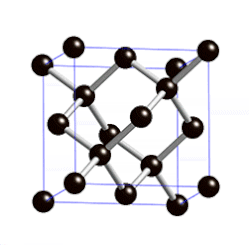Write4U
Valued Senior Member
http://en.wikipedia.org/wiki/Diamond_cubicIn reply to leopold, re: your #1296 post.
Don't kill the "messenger!" Yes...you're correct. You cannot "see" something that small, without a lot of help.
If you "read the whole reference" that I mentioned, it states you would need a "scanning electron microscope" to see them.
I have doubt that a "lattice structure" of carbon could exceed "normal" parameters of definitions as an element.
I agree that I made a misjudgment with the phrase "sub-molecular"....I should have said "smaller than a molecule". (is this better?)
........
I'm not "Mr. Wizard" or "Mr. Science" and have no ambitions to be an "authority" on the internet, or anywhere else...I just mentioned something I think was on PBS a couple of years ago! Yes, leopold...I'm aware of what "carbon" and it's six known forms are. I know what a frickin' diamond is!
Apparently nature did find a way to use these structures for different purposes. Is there a difference in the concepts of "adapt" and "adopt"? It is always thus. No matter how small a thing, it always seems to have certain properties which are shared by or compatible to other things. Potential uses of a structure are expressed and applied in many universal applications, if it is mathematically possible, it'll happen, maybe it already has.DIAMOND CUBIC CRYSTAL,
The diamond cubic crystal structure is a repeating pattern of 8 atoms that certain materials may adopt as they solidify. While the first known example was diamond, other elements in group 14 also adopt this structure, including α-tin, the semiconductors silicon and germanium, and silicon/germanium alloys in any proportion.
When we get smaller than that we end up with "elements" (fundamental atoms) and surprise, some atoms "really





